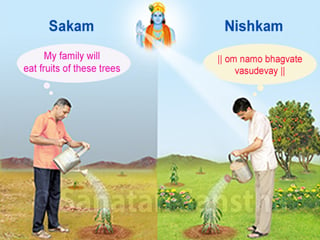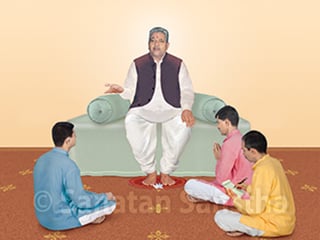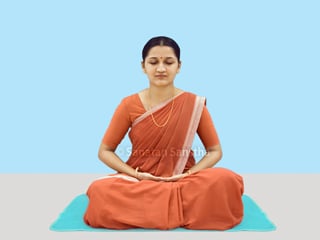As per Hindu Dharma (Righteousness) there are four Yugs. The four Yugs are Satyayug, Tretayug, Dwaparyug and Kaliyug. Each Yug is subdivided into a cycle of four Yugs. The current Kaliyug (Era of strife) is the fifth sub-Kaliyug of the main Kaliyug. Since the predominance of Raja-Tama components is at its peak in this Yug, it is very difficult to perform sadhana. However, since we are in a transition period, sadhana performed in this period is twenty times more beneficial than performed otherwise.
In the following article, it is explained how the paths of sadhana have changed over various Yugs.
1. Reduction in Shakti (Divine Energy) in people
over various Yugs and the paths of sadhana created by God
A. Dnyanyoga (Spiritual Path of knowledge)
-
Originated in the Satyayug : Since the earth was created by God and since people had qualities similar to God’s, the knowledge of the individual, that is, his Dnyan-shakti (Energy of Knowledge) when compared with all other components was higher in Satyayug. Hence, God created Dnyanyoga for such people.
-
Special features :Dnyanyoga results in manifestation of the true sagun (Materialised) form of God, that is, Dnyan-shakti through the medium of Kriya-shakti (Energy of action). In Satyayug, since the individual was in contact with the nirgun (Non-materialised) in its sagun form, through Dnyanyoga it was possible for him to go towards the nirgun form of God, that is, towards the real form of God.
B. Dhyanyoga (Spiritual Path of meditation)
-
Originated in Tretayug : Since the individual was distinct from God, that is, since there was a reduction in Dnyan-shakti, or the Dnyan-shakti in the individual was insufficient for God-realisation, God created Dhyanyoga, that is, with the help of Kriya-shakti concealed in the individual, God awakened the Dnyan-shakti; through its medium, He created paths of Yoga (Union with God) for God-realization.
-
Special features : Dhyanyoga results in manifestation of Dnyan-shakti, that is, in the real form of God. In the individual, with the help of the sagun in the Kriya-shakti, that is, through physical actions, the nirgun in him is awakened. Having control over the subtle-components in the self, which is the knowledge enriched form of God based on the truth arising from within, it can educate. The individual in the Tretayug was predominant in Kriya-shakti, hence, God created Dhyanyoga and to help the individual to merge with God as fast as possible, created these types of paths of Yoga.
C. Karmakanda
-
Originated in the Dwaparyug : Since Kriya-shakti in the individual meant for God-realisation declined and isolation from God increased, God created a path of Yoga of karmakanda with the help of Iccha-shakti (Energy of will), through which the Dnyan-shakti is awakened and leads the individual to God.
-
Special features : The real form of God is revealed through karmakanda with guidance from God and spiritual experiences. Providing the support of Kriya-shakti to the individual, the process that begins on the strength of this Kriya-shakti is understood on the strength of Iccha-shakti. Through this medium, the attraction of the individual for God increases and merges him into God. Since in the Dwaparyug Iccha-shakti was more in the individual, God created karmakanda as the Path to its awakening.
D. Bhaktiyoga (Spiritual Path of devotion)
-
Originated at the beginning of Kaliyug : Due to maximum separation from God, since the three components of iccha (desire, will), kriya (physical performance of a deed) and dnyan (Spiritual knowledge) unite, the individual will have to attain God through the sagun medium within himself, that is, with the help of his virtues and bhav (Spiritual emotion). Bhav was present at the beginning of Kaliyug; hence, it was possible for the individual to progress spiritually with the help of devotion. Thus, God made various Saints His medium, and created a Mahayoga like Bhaktiyoga that sustained a qualitative sagun nature.
-
Special features :Bhaktiyoga can bring about the union of the individual with God through the medium of bhav which depicts radiance of iccha, kriya, spiritual experiences and dnyan. Even if the individual does not have bhav in Bhaktiyoga, he can ascend to a superior level with the help of virtues; hence, it is known as ‘Mahayoga’
E. Gurukrupayoga
-
Origin in the period after Kaliyug :Since with passage of time the bhav in the individual has declined in the Kaliyug, the individual will have to carry out his journey from the basic focal point of the nirgun, that is, it will have to travel directly with the help of sagun aura of God. Hence, through the medium of a great soul such as His Holiness Dr. Athavale, God has created a perfect Yoga, that is, Gurukrupayoga.
-
Special features : .Gurukrupayoga gets sadhana performed from the individual in a manner that through his virtuous actions, the components of bhav, iccha, kriya and dnyan are created in their nirgun form. That is why, Gurukrupayoga is also called the perfect Yoga. Some support is required for following various other paths of Yoga, because all other paths of Yoga are dependent on vyashti (Individual), that is, on sagun. Moreover, to follow the path of sagun, a sagun-enriched support is necessary. Conversely, since Gurukrupayoga includes samashti (Society) sadhana, it is based on the nirgun. If the individual feels the need for sagun (meaning, support when required), the nirgun in the form of experiences will become the sagun support and perform the function of supporting the individual; hence, Gurukrupayoga will exist till the end of Kaliyug, and many people will follow this spiritual path.
2. All paths of sadhana reach the feet of Paramatma (Supreme Soul / God)
Waters from all rivers, streams, whether pure or impure, clean or dirty, with diverse tastes and salt content finally merge into the ocean. No matter what food man consumes, everything gets converted into only one type of energy (According to science – ATP), which is then absorbed by the cells. In the same way, no matter which Name of the Deity you chant, or perform sadhana as per which sect or path of worship, finally it will reach only Paramatma.
3. Comparative importance of types of sadhana and Yogabhakti (Mayabhakti
| Type of sadhana | Importance (%) |
|---|---|
| 1. Vyashti sadhana | 30 |
| 2. Samashti sadhana | 60 |
| 3. Sadhana for establishing the ‘Divine Kingdom’ | 90 |
| 4. Other types [sakam bhakti] | 10 |
Gurukrupayoga includes vyashti sadhana, samashti sadhana & sadhana for establishment of Divine Kingdom.
4. Vyashti and samashti sadhana
Sadhana has two aspects – vyashti sadhana and samashti sadhana.
Efforts made for individual spiritual progress are called vyashti sadhana, and those for the spiritual upliftment of the society are called samashti sadhana.
5. Sadhana as per Gurukrupayoga
‘गुरुकृपा हि केवलं शिष्यपरममङ्गलम् ।’, meaning, only with the Guru’s grace can a disciple attain Moksha [Final Liberation]. The speciality of Gurukrupayoga is that it encompasses all paths of sadhana; thus, this is an easy path for God-realisation. Sadhana performed so as to be blessed by a Guru and to obtain His grace is known as ‘Gurukrupayoga sadhana’. This is a perfect blend of vyashti sadhana and samashti sadhana
7. Sadhana through the medium of arts
A. Music and dance are the forms of art closest to the physical body; these are mediums through which God-realisation can take place faster
- Since the physical body of a seeker serves as the real medium in music and dance, the Chaitanya (Divine consciousness) from these forms of art depends upon the Sattva component in the seeker. The more sattvik (Sattva predominant) the attitude of a seeker, the more sattvik his art becomes.
- Since music and dance are forms of art directly associated with the bodies of seekers, God-realisation can take place faster through music and art when compared with other forms of art.
Since art emerges from within in music and dance, the likelihood of experiences and spiritual experiences arising from the energy of God are more. Conversely, in other forms of art, for example sculpture, drawing etc., art unfolds through the use of external mediums. The duration required for an artist to become experienced in these fields takes longer. That is why, it said that through the mediums of music and dance, God-realisation can take place faster.
B. Nadopasana (Worship through sound) is a vihangam (Fast) path in sadhana for God-realisation :
A seeker who performs Nadopasana attains faster God-realisation when compared with others. Since the universe was created from sound, every component in the universe loves music. Since God too is fond of music, a seeker attains faster God-realisation by performing sadhana through this medium. God is pleased more easily by a seeker who performs sadhana through music. If singers use music for God-realisation, they can attain God-realisation faster. Unlike in other Yugs, in this Kaliyug artists have the greatest opportunity for God-realisation. The artist who realises this will be able to progress spiritually. However, in the Kaliyug, since the atmosphere is Raja-Tama-predominant, singers give more importance to attaining fame than to God-realisation. Very rarely a singer attains God-realisation through the medium of music.
C. Devotion unto the nirgun is necessary to merge with musical notes, and if the singer is spiritually evolved, the audience gets a vision of God in him :
To blend with musical notes you need devotion unto the nirguntattva. In devotion of the saguntattva, a sagun form of God, that is, an Idol or image, appears before the devotee. However, in music performed as sadhana, the singer first has to develop immense love for God; only then can he love the notes with the same intense bhav and can bring about manifestation of God within himself. If the spiritual level of the singer is above 50%, upon hearing the notes the audience can see an image of God. Only such a singer can perform music as sadhana and attain Moksha.
D. The true samashti sadhana for artists is to study art from the spiritual perspective and convince the society of its importance :
The true samashti sadhana for artists is to study art from the spiritual perspective and convince the society of its importance. If this does not happen, the society will view these arts merely as forms of entertainment. God Himself has created various forms of art not just as mediums of entertainment but as mediums for God-realisation. Artists must use their skills in art only for God-realisation. Only then will the purpose of human life be fulfilled.
Reference : Sanatan’s Holy text ‘Sadhana (Spiritual practice) (General information and importance)’

 Stages in the journey towards God-realisation
Stages in the journey towards God-realisation Why Nishkam sadhana is superior to Sakam sadhana ?
Why Nishkam sadhana is superior to Sakam sadhana ? Importance of performing sadhana under the guidance of a guru
Importance of performing sadhana under the guidance of a guru What is sadhana (Spiritual practice) ?
What is sadhana (Spiritual practice) ?